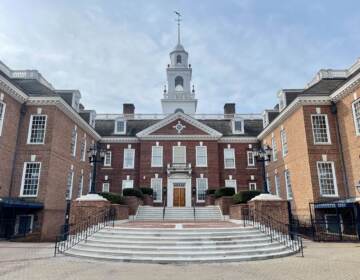Destructive beetle discovered in Delaware

Emerald ash borer (Vermont Invasives Flickr photo)
Delaware’s Department of Agriculture is concerned about the livelihood of local ash trees, after finding an invasive beetle in the state.
Delaware is the 28th state to find the emerald ash borer, a beetle with a history of killing ash trees rapidly.
The department expects the impact to be minimal in Delaware, as ash trees make up only 2 percent of the state’s tree stock. Still, the state is taking measures to protect its ash trees.
“Because this was not unexpected, we have been working for several years with cities, towns and civic groups on plans to manage and replace ash trees,” said Dr. Faith Kuehn, administrator of DDA’s Plant Industries Section, which oversees EAB detection, control and prevention in partnership with the U.S. Department of Agriculture’s Animal and Plant Health Inspection Service.
The beetle is originally from Asia, and experts assume it arrived in the U.S. through wood-packing material. The USDA tried to eradicate the insect when it was first discovered, but their efforts proved unsuccessful.
As an infestation progresses, trees becomes weak and can drop branches or even fall over.
“As this infestation moves it’s going to wipe out almost all the ash in its path,” said State Forester Dr. Mike Valenti.
The Delaware beetle was found in a trap placed in an ash tree in New Castle County. The insects can fly to new areas, or travel on firewood, timber and nursery stock.
There aren’t many ash trees in the state’s forests or parks, but some city municipalities, like Newark and Wilmington, and some suburban areas in New Castle County, plant them as street trees or in their city parks.
The adult beetles appear in the spring and mate shortly thereafter, with each female laying 60 to 90 eggs in a lifetime, according to the department. The insects breed on ash trees, so high-density areas are the most vulnerable.
“Because trees are so sparse here in Delaware, I don’t think we’re going to see the impacts like these other states, because we have an ash tree here, an ash tree there,” Valenti said.
On a yearly basis the combination of state and federal funding to manage the insect is about $29 million, Kuehn said.
Healthy trees can be treated with pesticides to prevent infestation, and trees in declining health can be removed, she said.
Valenti said states like Ohio and Michigan, which were the first to encounter the insect, faced enormous costs for tree removal. If a homeowner needs to remove one ash tree, it could cost up to $2,000 for the job.
Valenti said treating trees to prevent infestations is not always successful.
“It goes like a steam roller, so you can try to prevent destruction of your tree, but when you get thousands of these beetles in an infestation in a high density ash area there’s really going to be no hope,” he said.
Delaware will be added to a federal quarantine already in 27 other states restricting the interstate shipment of all ash wood and wood products. Some shipments out of state may be permitted if certain requirements are met and a federal permit is issued, according to the department.
Kuehn said nursery growers and wholesale nursery stock distributors have either eliminated or reduced their ash inventory, and most retail garden centers do not offer ash trees for sale.
She advises nursery businesses that choose to continue selling ash trees to examine the stock upon arrival, and nurseries and landscapers should continue to examine branches and trunks for signs of emerald ash borer infestation.
Delaware has monitored emerald ash borer infestations since 2004, using both visual surveys and baited traps that attract the insects. Grant funding from the U.S. Department of Agriculture has supported monitoring and forest pest outreach efforts. Delaware’s Department of Agriculture said it will continue to monitor the issue over the coming months.
The department also has been educating residents and municipalities about the issue in recent months. Homeowners, municipalities and civic groups also can find advice at de.gov/ashtrees.
“If in fact we’ve caught the leading edge, there’s time for people to do something before the infestation becomes as heavy as some as some of the places in the Midwest,” Kuehn said.
WHYY is your source for fact-based, in-depth journalism and information. As a nonprofit organization, we rely on financial support from readers like you. Please give today.





